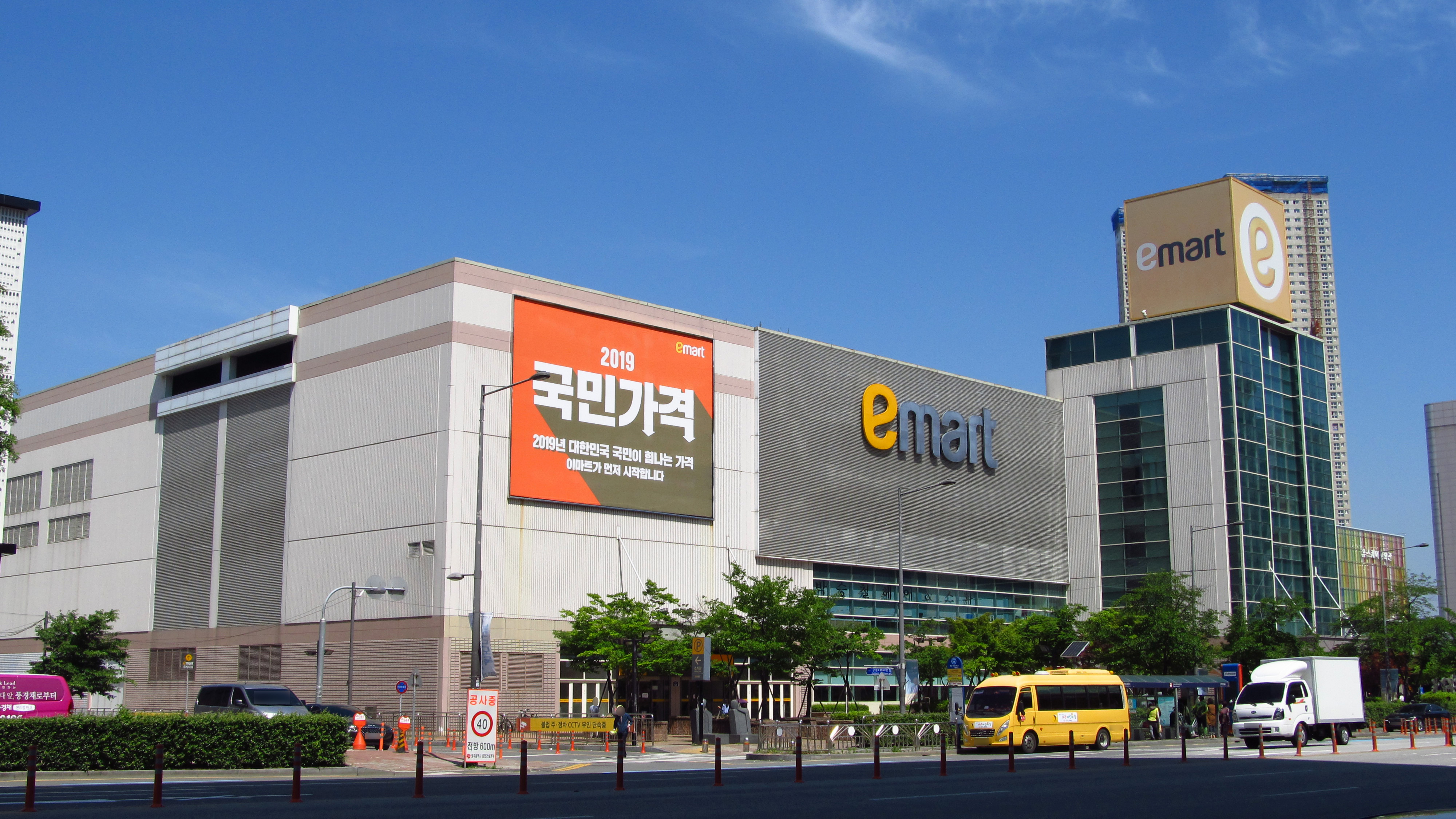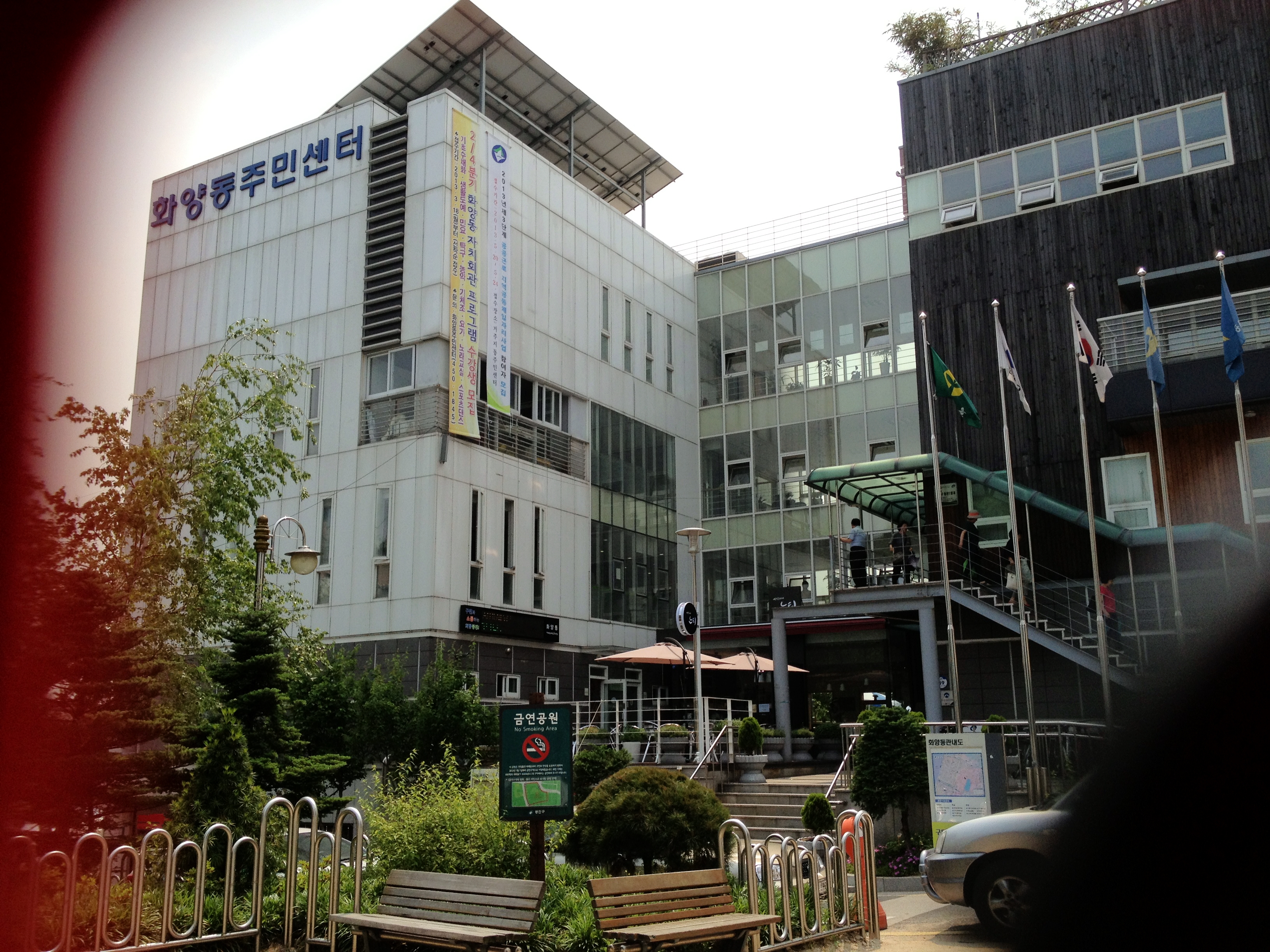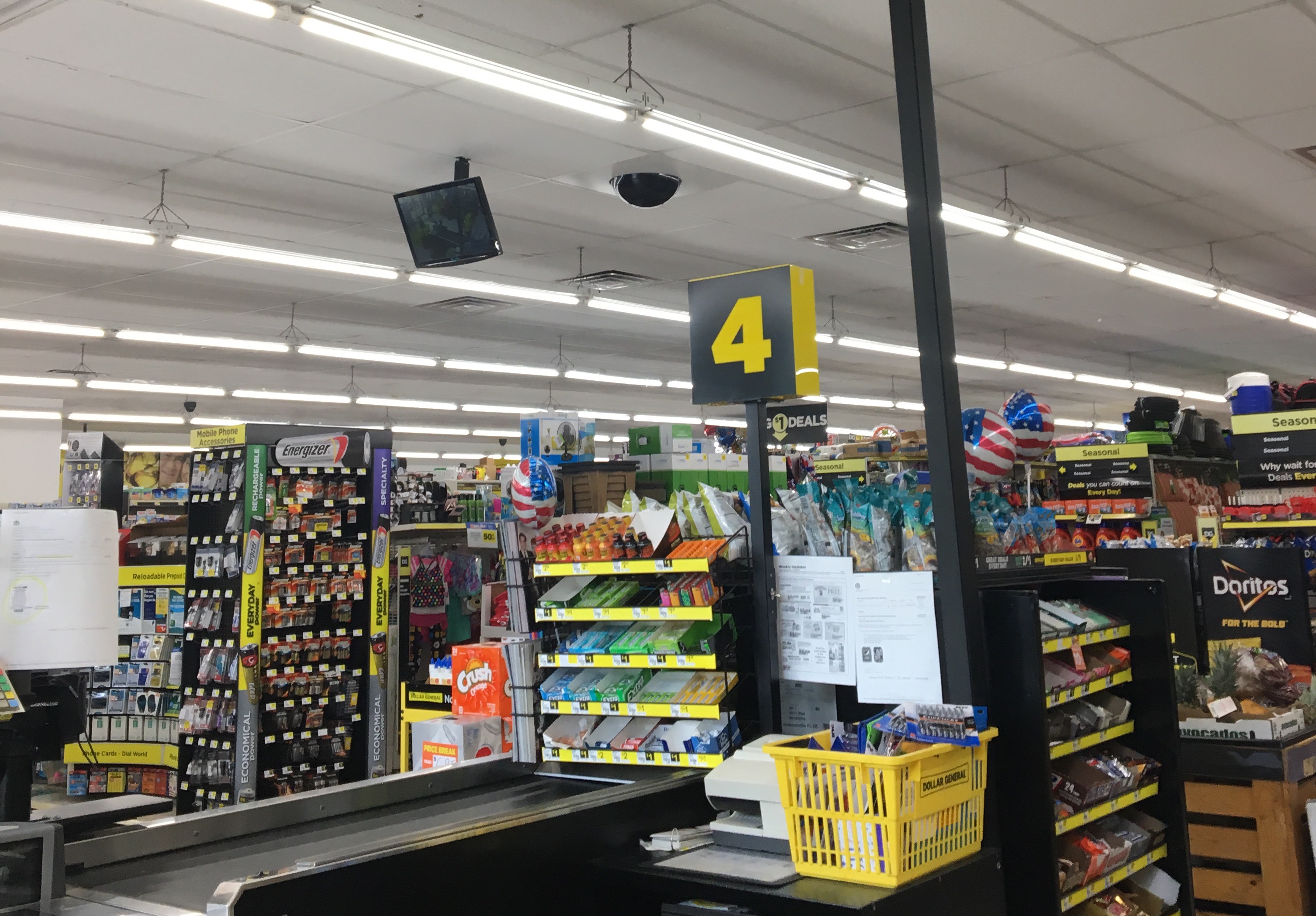|
Seongsu Station
Seongsu Station ( ko, 성수역) is a rapid transit station on Seoul Subway Line 2. It is located in Seongsu-dong in the Seongdong-gu administrative district of Seoul. It is also the southeastern terminus of Line 2's Seongsu Branch to Sinseol-dong. Trains needing to be serviced take the Seongsu Branch from this station and go to the Gunja Train Depot behind Yongdap Station. The platform is elevated and features 4 tracks. The main circle route of Line 2 runs on the inside pair of tracks while the Sinseol-dong branch is served by the outside pair of tracks. The station has four exits and is connected to two bus routes as well as a local shuttle bus which services the various apartment complexes in the area around the station. The stations services Seongsu 1ga 1 dong, Seongsu 2ga 1 dong, and Seongsu 2ga 3 dong. The area around the station is primarily commercial and light industrial but gives way to mixed-use development and residential further from station. Exits 1 and 2 service ... [...More Info...] [...Related Items...] OR: [Wikipedia] [Google] [Baidu] |
Seongdong-gu
Seongdong District (Seongdong-gu) is one of the 25 '' gu'' which make up the city of Seoul, South Korea. It is situated on the north bank of the Han River. It is divided into 20 ''dong'' (neighbourhoods). Administrative divisions Seongdong District consists of 20 administrative dongs (haengjeong-dong, ) * Doseon-dong () ** Hongik-dong (): legal dong (beopjeong-dong, ) * Eungbong-dong () * Haengdang-dong () 1∼2 * Geumho-dong () 1∼4 * Majang-dong () * Oksu-dong () 1∼2 * Sageun-dong () * Seongsu 1ga 1 dong () * Seongsu 1ga 2 dong () * Seongsu 2ga 1-dong () * Seongsu 2ga 3-dong () * Songjeong-dong () * Yongdap-dong () * Wangsimni-dong () 1∼2 ** Sangwangsimni-dong (): legal dong (beopjeong-dong, ) ** Hawangsimni-dong (): legal dong (beopjeong-dong, ) Transportation Railways *KORAIL ;* Jungang Line ;;*(Dongdaemun-gu) ← Wangsimni ─ Eungbong ─ Oksu → (Yongsan-gu) ;*Bundang Line ;;* Wangsimni ─ Seoul Forest → (Gangnam-gu) *Seoul Metro ;* Seoul Undergroun ... [...More Info...] [...Related Items...] OR: [Wikipedia] [Google] [Baidu] |
Sports Complex Station (Seoul)
Sports Complex station is a station on Seoul Subway Line 2 and Seoul Subway Line 9. As its name indicates, it serves the nearby Seoul Sports Complex including Seoul Olympic Stadium. Asia Park is also accessible by foot from the station. In early 2015 this station become a transfer station between Line 2 and Line 9 of the Seoul Subway The Seoul Metropolitan Subway is a metropolitan railway system consisting of 23 rapid transit, light metro, commuter rail and people mover lines located in northwest South Korea. The system serves most of the Seoul Metropolitan Area including .... Station layout Line 2 Line 9 Gallery File:Q491563 Sports Complex B01.jpg, Station Sign (Line 9) File:20220308 9호선 종합운동장역.jpg, Station platform (Line 9) File:Seoul-metro-Sports-complex-station-entrance-2-20180914-142930.jpg, Exit 2 File:Seoul-metro-218-Sports-complex-station-sign-20180914-142214.jpg, Station sign (Line 2) References Seoul Metropolitan Subway stations ... [...More Info...] [...Related Items...] OR: [Wikipedia] [Google] [Baidu] |
Konkuk University Station
Konkuk University Station ( ko, 건대입구역) is a rapid transit station on Seoul Subway Line 2 and Seoul Subway Line 7. It is located in Hwayang-dong in the Gwangjin-gu administrative district of Seoul. It is adjacent to Konkuk University from which it takes its name. Line 2 is serviced by an elevated platform while Line 7 is serviced by an underground platform. The station has connections to ten bus lines through its six exits as well as a connection to the airport shuttle bus. The station services Hwayang-dong as well as Jayang-dong and Noyu-dong. The area around the station is mixed residential and small commercial businesses. Exits from the underground Line 7 platform open into Konkuk University and the adjacent Star City shopping and high-rise residential tower complex. Station layout Line 2 Line 7 History The station is part of the original set of stations which made up the first phase of Line 2. It was built on October 31, 1980 at Konkuk University intersect ... [...More Info...] [...Related Items...] OR: [Wikipedia] [Google] [Baidu] |
Ttukseom Station
Ttukseom Station is a station on the Seoul Subway Line 2. It is located in Seongsu-dong, Seongdong-gu, Seoul, and is near Seoul Forest Seoul Forest () is a large park in Seongdong-gu, Seoul, South Korea. It is open year-round, and admission is free. Seoul Forest opened in June 2005. The city government spent 235.2 billion won in development. It is the third largest park in Seou .... Station layout References Seoul Metropolitan Subway stations Railway stations opened in 1983 Metro stations in Seongdong District 1983 establishments in South Korea 20th-century architecture in South Korea {{Seoul-metro-station-stub ... [...More Info...] [...Related Items...] OR: [Wikipedia] [Google] [Baidu] |
Island Platform
An island platform (also center platform, centre platform) is a station layout arrangement where a single platform is positioned between two tracks within a railway station, tram stop or transitway interchange. Island platforms are popular on twin-track routes due to pragmatic and cost reasons. They are also useful within larger stations where local and express services for the same direction of travel can be provided from opposite sides of the same platform thereby simplifying transfers between the two tracks. An alternative arrangement is to position side platforms on either side of the tracks. The historical use of island platforms depends greatly upon the location. In the United Kingdom the use of island platforms is relatively common when the railway line is in a cutting or raised on an embankment, as this makes it easier to provide access to the platform without walking across the tracks. Advantages and tradeoffs Island platforms are necessary for any station with many th ... [...More Info...] [...Related Items...] OR: [Wikipedia] [Google] [Baidu] |
E-mart
e-mart () is the largest retailer in South Korea. There were 160 stores across the country as of December 2016. It was founded on 12 November 1993 by Shinsegae as the first discount retailer in South Korea. E-Mart is the oldest and largest discount store chain in Korea with total sales volume exceeding US$9.4 billion in 2009. With new store openings and acquisition of Wal-Mart Korea in 2006, E-Mart is enjoying its retail leadership in the discount store market. E-mart offers everything from food to clothes to diapers, and provides a very large variety of merchandise. E-mart has a website, where products can be bought or viewed online. E-Mart is the first Korean retailer to open a retail store in China with the aim to become one of top leading global retailers. In January 2011, there were 27 stores in China. By February 2014, China's store count shrunk to 13 stores. History E-Mart opened its first store in Chang-dong, Dobong-gu, Seoul on November 12, 1993, and opened its first ... [...More Info...] [...Related Items...] OR: [Wikipedia] [Google] [Baidu] |
Hwayang-dong
Hwayang-dong is a '' dong'' located in west Gwangjin-gu in Seoul, South Korea. It was incorporated into Gwangjin-gu on 13 August 1949. It is a mixed residential and small business area. Mojin-dong is also administered by Hwayang-dong and contains Konkuk University. See also *Administrative divisions of South Korea South Korea is made up of 17 first-tier administrative divisions: 6 metropolitan cities (''gwangyeoksi'' ), 1 special city (''teukbyeolsi'' ), 1 special self-governing city (''teukbyeol-jachisi'' ), and 9 provinces ('' do'' ), including one ... References * External links Gwangjin-gu official website in EnglishMap of Gwangjin-guat the Gwangjin-gu official website Hwayang-dong resident office website Neighbourhoods of Gwangjin District {{Seoul-geo-stub ... [...More Info...] [...Related Items...] OR: [Wikipedia] [Google] [Baidu] |
Han River (Korea)
The Han River or Hangang () is a major river in South Korea and the fourth longest river on the Korean peninsula after the Yalu River, Amnok (Yalu), Tumen River, Tuman (Tumen), and Nakdong rivers. The river begins as two smaller rivers in the eastern mountains of the Korean peninsula, which then converge near Seoul, the capital of the country. The Hangang River and its surrounding area have played an important role in Korean history. The Three Kingdoms of Korea strove to take control of this land, where the river was used as a trade route to China (via the Yellow Sea). The river is no longer actively used for navigation, because its estuary is located at the Korean Demilitarized Zone, borders of the two Koreas, barred for entrance by any civilian. The river serves as a water source for over 12 million South Koreans. In July 2000, the United States military admitted to having dumped formaldehyde in the sewer system connected to the river, causing protests. The lower stretches ... [...More Info...] [...Related Items...] OR: [Wikipedia] [Google] [Baidu] |
Concourse
A concourse is a place where pathways or roads meet, such as in a hotel, a convention center, a railway station, an airport terminal, a hall, or other space. The term is not limited to places where there are literally pathways or roadways or train tracks joining. An alternate meaning now is "an open space or hall (as in a railway terminal) where crowds gather." In this meaning as a place where crowds gather, while many persons in any crowd no doubt have followed different paths in their lives to get to the place, there need not be notable specific roadways leading to the place. Examples Examples of concourses include: * Meeting halls * Universities * Railway stations * Conference centres * Hotels * Airport terminals * Shopping malls or portions of shopping malls which are often called "shopping concourses" * Sports arenas and stadiums Gallery Outdoor concourses Image:Earnley concourse West Sussex.jpg, Earnley Concourse, West Sussex, 2009This local village name for it ... [...More Info...] [...Related Items...] OR: [Wikipedia] [Google] [Baidu] |
Variety Store
A variety store (also five and dime (historic), pound shop, or dollar store) is a retail store that sells general merchandise, such as apparel, automotive parts, dry goods, toys, hardware, home furnishings, and a selection of groceries. It usually sells them at discounted prices, sometimes at one or several fixed price points, such as one dollar, or historically, five and ten cents. Variety stores do not include larger formats: general merchandise superstores (hypermarkets) such as Target and Walmart. Warehouse clubs like Costco, grocery stores, and department stores are also not considered variety stores. Economics Pricing and margins Some items are offered at a considerable discount over other retailers, whereas others are at the same price point. There are two ways variety stores make a profit: * Buying and selling vast amounts of goods at heavily discounted prices provides a small profit margin multiplied by the volume of sales. * Pricing many items at prices that are h ... [...More Info...] [...Related Items...] OR: [Wikipedia] [Google] [Baidu] |




